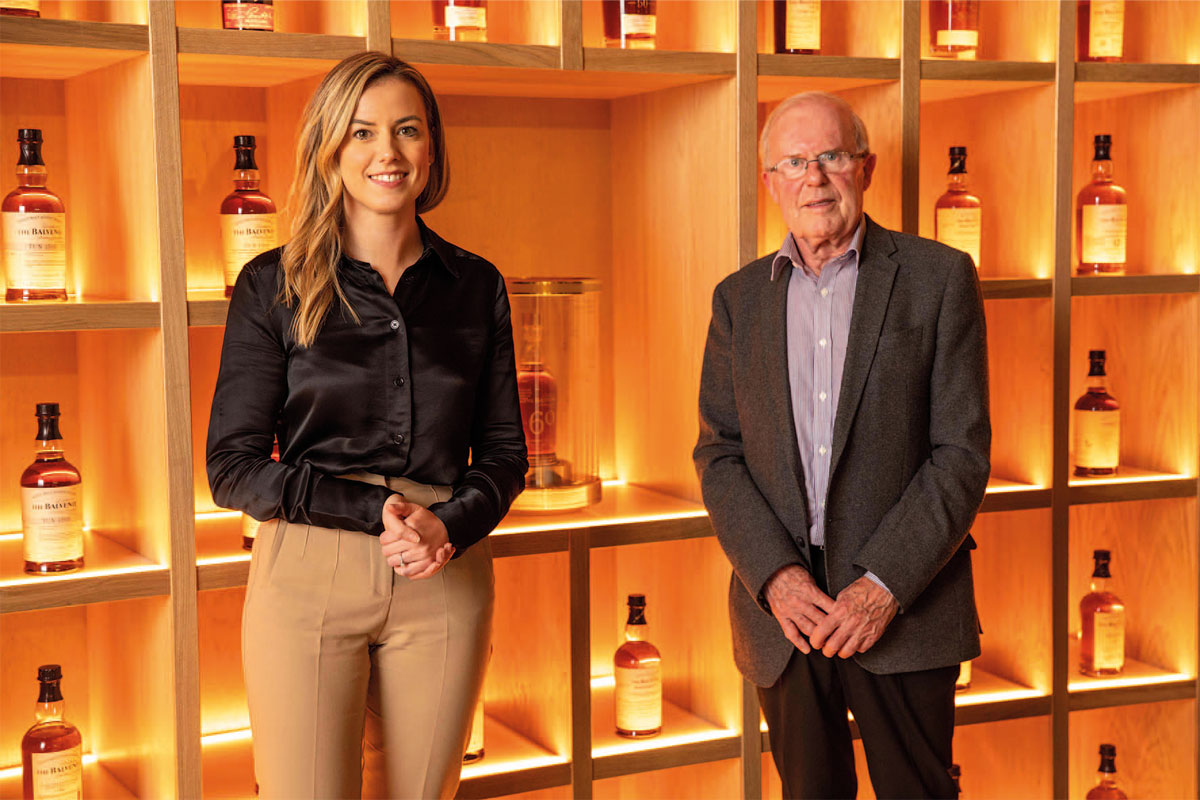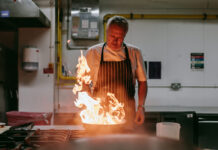Former apprentice now heads the blending team at revered single malt

ANYONE who has ever bought a bottle of single malt The Balvenie will be familiar with the signature on the label.
David Stewart, one of Scotch whisky’s most well-respected names, has had his signature on each bottle of the Speyside whisky for decades.
But all that’s about to change.
Stewart, a 60-year industry veteran, is now semi-retired and preparing to pass the torch to malt master Kelsey McKechnie.
Officially announced as apprentice malt master in 2018 and promoted to malt master late last year, Kelsey has been gradually assuming more responsibility for the creation of The Balvenie range over the past few years.
“It’s amazing that there are so many women coming into these visible roles.”
Taking over from a living legend could be a daunting prospect, but speaking to SLTN from the company’s blending plant in Bellshill Kelsey seemed to be taking the whole thing in her stride.
“I couldn’t pinpoint a time when it’s felt like my roles and responsibilities have had a big shift since I’ve started working with the team,” she said.
“We work in such a close team – it’s very small – and so actually just over time you naturally just take on more roles and you do more of the blending on your own. And you just feel more confident doing it.
“So it hasn’t been that over the years someone has said ‘at the end of June you’ll start blending Balvenie 30 on your own’. Just as time has progressed and you do more nosing and you understand the profile of the spirit that we’re looking for and what we’re wanting to get from each product, I’ve just naturally started taking on more.”
Stewart continues to consult with the blending team and is on hand to answer any questions and share his six decades of experience, but Kelsey said their relationship has ‘moved from more of a mentorship to more of a colleague/friendship’.
“David has still been on hand, and he will continue to be,” she said.
“Sixty years of his life has been spent at Balvenie and his knowledge is [unparalleled].
“It amazes me that we have over a million casks in Dufftown and when you chat to him he can talk about single casks and where they went. It’s just fantastic.”
Speaking of when her name will replace David’s on bottles of The Balvenie, Kelsey said it’s likely to happen ‘over the next months and years’ but stresses that she isn’t in a rush.
Patience, she said, is one of the most important lessons she learned from her former mentor.
Cask finishing – where matured whisky is transferred to a different type of cask for an additional, shorter period of time before bottling – is a good example.
It’s a process David first brought to The Balvenie range in the 1980s. Now each expression of The Balvenie’s core range is finished in a particular type of cask, with the 12 year old Doublewood finished in sherry casks, the 14 year old Caribbean Cask – Kelsey’s favourite of the range – finished in rum casks, the 16 year old French Oak finished in French wine casks and the 21 year old Portwood (David’s favourite) finished in port pipes.
Getting the best results, said Kelsey, requires patience.
She explained: “The main thing I always say (I learned from David) is just really to be patient. It takes such a long time to make whisky so all the casks we’re laying down today – whether it’s our sherry butts or our port pipes, whatever the wood type that’s coming in – typically we’re laying everything down for finishing either the back end of next year or going into the year after. It takes such a long time.”
The finishing, of course, is just the end of a maturation process that has already taken years. And so the team has to be able to think years – even decades – ahead to ensure they have stock of the right age and quality, which can then be transferred to the sherry, rum, wine or port casks for finishing.
Ensuring batches are ready when they need to be requires forward planning and patience in equal measure.
“It isn’t anything that can happen overnight,” said Kelsey. “So David has really been great at instilling the fact that we do need to be patient and to have all our ducks in a row, so to speak, so far in advance.
“That’s really how we make Balvenie great and how we maintain the quality and the consistency – just allowing the spirit and the oak to do their thing in time.”
It’s not just the spirit which develops over time. Recent years have also seen the industry itself evolve into a more inclusive place, with a growing number of women in top roles.
In addition to Kelsey, high profile master blenders include Rachel Barrie (Glendronach, Benriach), Kirsteen Campbell (The Macallan), Julieann Fernandez (Bunnahabhain, Deanston and Tobermory), and Emma Walker (Johnnie Walker).
“It definitely is a male-dominated industry but I definitely think things are changing,” Kelsey told SLTN.
“There’s more and more women coming into these sort of outward-facing roles and, actually, until I had this role I had only worked for women within this industry – in the lab and in different places.
“It’s amazing that there are so many women that are coming into visible roles so that more women can look at these positions, and it’s just become more available to them.”
The category, too, is becoming more accessible, reckoned Kelsey.
She said that, while the connoisseur side of the sector is still well catered for, she thinks whisky is becoming more welcoming to newcomers.
“I definitely think in the eight or nine years that I’ve been in the industry there’s been a big change in how people order drinks,” said Kelsey.
“I think many moons ago people would go into a bar and maybe feel a little bit sheepish about ordering a whisky because they didn’t know where the distillery was, or they didn’t know if it was a single malt or a blend.
“But actually, now, a lot of people are just driven by what they like. And a lot of the intensity around ‘do you know everything about the whisky you’re ordering?’ has been taken away.”
And there could be more changes to come.
Looking ahead, Kelsey said that – like David before her – she wants to be known as an innovator within the industry.
“First and foremost, we want to make sure that the quality doesn’t change,” she said.
“It’s great for a reason. It’s really important to me to ensure the quality and the consistency of all of our products going forward.
“But one of the most important and exciting things is innovation. It’s what we do at Balvenie. We’ve got a lot bubbling away in the background and I’ve been looking forward to launching more and more variants in the years to come.”



















